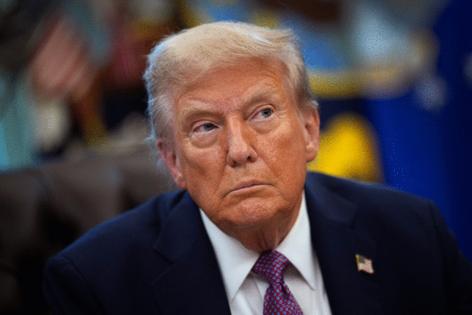Trump announces crackdown on drug ads on TV, social media
Published in News & Features
The Trump administration announced plans to crack down on pharmaceutical advertising on television and social media platforms that could disrupt billions of dollars in annual ad spending.
President Donald Trump signed a presidential memorandum on Tuesday that calls on federal health agencies to require pharmaceutical companies to disclose more side effects in their ads and enforce existing rules about misleading ads. The administration is pitching the moves as a way to increase transparency for patients.
The U.S. is the only place, besides New Zealand, where pharma companies can directly advertise to consumers. Limiting pharmaceutical advertisements has been a longtime priority for Health and Human Services Secretary Robert F. Kennedy Jr., though the new regulations would stop short of banning the ads entirely.
But even adding stricter requirements to the ads will likely hit both pharmaceutical companies and the media companies that rely heavily on those advertising dollars.
Drug companies spent $10.8 billion in 2024 on direct-to-consumer pharmaceutical advertising in total, according to a report from the advertising data firm MediaRadar. AbbVie Inc. and Pfizer Inc. were particularly big spenders. AbbVie alone spent $2 billion on direct-to-consumer drug ads last year, primarily on advertising for the company’s anti-inflammatory drugs Skyrizi and Rinvoq. The medicines brought in more than $6.5 billion for AbbVie in the second quarter of 2025.
Aside from new regulations, the agencies also plan to more strictly enforce existing rules around misleading advertising. The Food and Drug Administration plans to send 100 cease-and-desist letters and thousands of warning letters to companies related to pharmaceutical advertising on Tuesday, a senior administration official said.
Proponents of drug advertising say the ads can prompt patients to talk to their doctors about medical issues, but critics point out that the ads generally feature expensive, brand-name medications.
Bloomberg first reported that the administration was considering increasing requirements that companies disclose side effects in June.
Side effects
A senior administration official confirmed that the new Trump administration regulations may require broadcast ads to be longer to ensure they disclose the full risk profile of medications. Another official clarified that the goal is not to reduce the number of ads, but ensure patients have full information about side effects.
Before the loosening of advertising regulations by the FDA in 1997, U.S. pharma companies had to list all possible side effects for a medication if they wanted to mention which condition the drug being advertised was intended to treat. Reading out the long lists drove up costs for air time, making the ads less practical.
That FDA change in 1997 allowed ads to disclose fewer side effects and also allowed companies to direct customers to talk to their doctors, call a telephone number or visit a website to get more information on the advertised drugs. In the following years, TV pharma ad spending surged.
Last year, 59% of the pharmaceutical industry’s expenditures were on TV advertising, making pharma the third-highest spending industry, according to MediaRadar.
Social media
The Trump administration is also planning to ensure drug ads made by influencers and other social media posts abide by the same standards applied to TV, an administration official said.
The FDA released draft guidelines for social media in 2014, which haven’t been updated in the decade since drug ads proliferated.
In 2023, a Bloomberg Law investigation found that the FDA’s prescription drug office had sent just a handful of warning letters to pharmaceutical companies about ad violations or questionable promotional activities on social media platforms including Facebook, Instagram and YouTube. None of the letters available in the database mention TikTok, the social media platform that’s recently exploded with mentions of popular weight-loss medications, including sponsored posts for telehealth companies that sell the drugs. TikTok and other platforms have taken steps to rein in weight-loss related content, though it hasn’t been easy.
Research firm Emarketer projected that the pharmaceutical industry would spend more than $19 billion on online marketing in 2024. The spending was driven in part by ads for weight-loss and diabetes medications.
Telehealth companies
Administration officials said they’d also be taking a closer look at advertisements from telehealth companies, which operate differently from traditional pharma companies. They declined to mention specific companies, but noted a Super Bowl advertisement from a telehealth company that received criticism from senators.
In February, Republican Senator Roger Marshall of Kansas and Democratic Senator Dick Durbin of Illinois sent a letter to the FDA about telehealth company Hims & Hers Health Inc.’s Super Bowl ad, claiming it failed to disclose key safety and risk information. Hims defended the ad, saying it didn’t advertise one treatment or solution, but aimed to raise awareness about obesity. The telehealth company is far from the only one, however, that advertises access to prescription drugs for common conditions like erectile dysfunction, weight loss and hair loss.
Earlier Tuesday, the administration mentioned greater enforcement by HHS, FDA, the Federal Trade Commission and the Department of Justice on ads run by telehealth companies and social media influencers in its Make America Healthy Again strategy it released.
(With assistance from Gerry Smith.)
©2025 Bloomberg L.P. Visit bloomberg.com. Distributed by Tribune Content Agency, LLC.







Comments